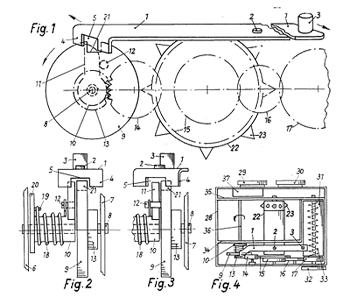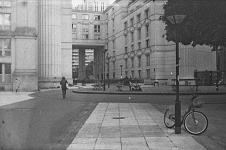|
Tessina L |

Manufactured or assembled in Swiss from 1960 to (After) 1980.
Index of rarity in France: Rare (among non-specialized garage sales)
Inventory number: 14712
See the complete technical specifications
Chronology of cameras Tessina
The Tessina is among the smallest reflex cameras in the world. Another similarly-minded camera is also Swiss, called the Lecoultre Compass, but it dates back to 1938.
The Tessina was invented by Rudolf Steineck, born in Dresden in 1905. The first patent filed in Switzerland dates back to March 25, 1954. The same patent was filed in the United States in 1954 (December 1, 1954), providing an illustration:

There are also two patents for which Paul Nagel (brother of Dr. Nagel, the inventor of the Kodak Retina) is a co-inventor. These two patents, DE1037842 and DE1041351, pertain to a rewinding device and a shutter and transport device for photographic cameras with automatic film transport.


The camera was manufactured by W. Siegrist & Cie AG in Grechen, Switzerland, and distributed by Concava S.A. in Lugano, Switzerland, where Steineck resided. Lugano is located in the canton of Tessin, which inspired the name Tessina. Concava S.A. was founded by Steineck following financial disputes with Steineck Kamerawerk, his company established in 1948 in Germany for the production of the Steineck A.B.C.
Like other Swiss miniature cameras, the Tessina bridges the gap between watchmaking and photography. Its 400 components are machined to the same standards as Swiss watches, with rubies even used to reduce friction between different parts. In fact, a very rare "Tessina 17 jewels" watch manufactured by Buler in Switzerland, produced in 200 units, can be mounted on its accessory shoe, making it a rather imposing wristwatch with a brown or black leather strap.
The Tessina is a twin-lens reflex camera, with the two Tessinon 2.8/25 mm lenses placed almost side by side. Behind the left lens, a mirror reflects the image upwards towards the viewfinder. Behind the other lens, a mirror reflects the image onto the film plane. The camera uses 35mm film in a specific cassette, containing 41 cm of film. The film moves flat, and each image measures 14 x 21 mm. The Tessina is equipped with a mechanical motor that advances about 10 frames. The motor is relatively noisy; however, a limited edition of fully silent models developed in the 1960s, equipped with Teflon gears, found global use in espionage.
A folding viewfinder also allows eye-level framing.
Above the camera, there is a small exposure table. The aperture setting is done with one of the two dials, which is concentric with the frame counter. The other dial allows focusing adjustment, and at the center of this dial is a depth of field table.
The shutter speed adjustment (from 1/2 to 1/500th of a second + B) is located on the rear face. The shutter release is on the front face, next to the viewfinder lens. It has a rectangular shape and a threading.
The Tessina is part of a photographic system. Where the exposure table is, it is possible to insert an accessory shoe. A flash, a light meter, the Tessina watch, or a simple plate providing the ASA/speed/aperture correspondence can be attached. The sync socket is located at the back, near a dial indicating the type of flash.
The ground glass of the viewfinder allows attaching various sighting accessories, such as an angle finder or an 8x magnifying loupe. Underneath the camera, there is a mounting system for adding a plate with a tripod thread and eyelets for attaching a neck chain, watch bracelet, or, more simply, another more detailed "instruction manual" plate.
Three models were created: Tessina Automatic 35, Tessina 35 et Tessina L. They are nearly identical; the Automatic 35 stands out from the other two with its X, F, and M flash sync, while the 35 and L have only X and M flash sync.
The Tessina L has a notch on its accessory shoe that allows it to connect the aperture and frame counter dial to a miniature light meter allowing coupling.
These three models are available in brushed aluminum, matte black, red, gold, and blue. Their production is estimated at 20,000 units.
A prototype of a faster-paced motor was created but never went into production.
The Tessina was used by various espionage or police organizations (Stasi, CIA, etc.). It was also used by the fake plumbers in the Watergate scandal and, more anecdotally, in Hitchcock's film "Topaz".
Sources:
- Submin.com
- Photography and Watchmaking (Luc Debraine, Olivier Lugon) Infolio
- Spy Cameras (Michael Pritchard and Douglas St. Denny) CCP
- The Spy Camera from Granges (Dominik Landwehr) web.


Interesting links or bibliography :
Add a link or element of bibliography, a picture taken with this camera, a picture of box or an ads about this camera
Your photos taken with the same camera:

|
Cameras from Ebay France (Tessina) (Uploaded each 3 hours)








